The Philip & Maria Van Rensselaer CollectionFirst Generation 1747-1830
Philip Van Rensselaer (1747-1798) was a wealthy merchant and sloop owner and a member of the illustrious Van Rensselaer family. Maria Sanders (1749-1830), his wife, herself brought a share of wealth and clout into the marital partnership, as the daughter of one of Albany's mayors and leading businessmen. Cherry Hill, the substantial “mansion-house” built for the couple and filled by them with fine textiles and furnishings, bears witness to Philip's business success and the couple's status among the Albany elite.
← Back to CollectionsPalampore
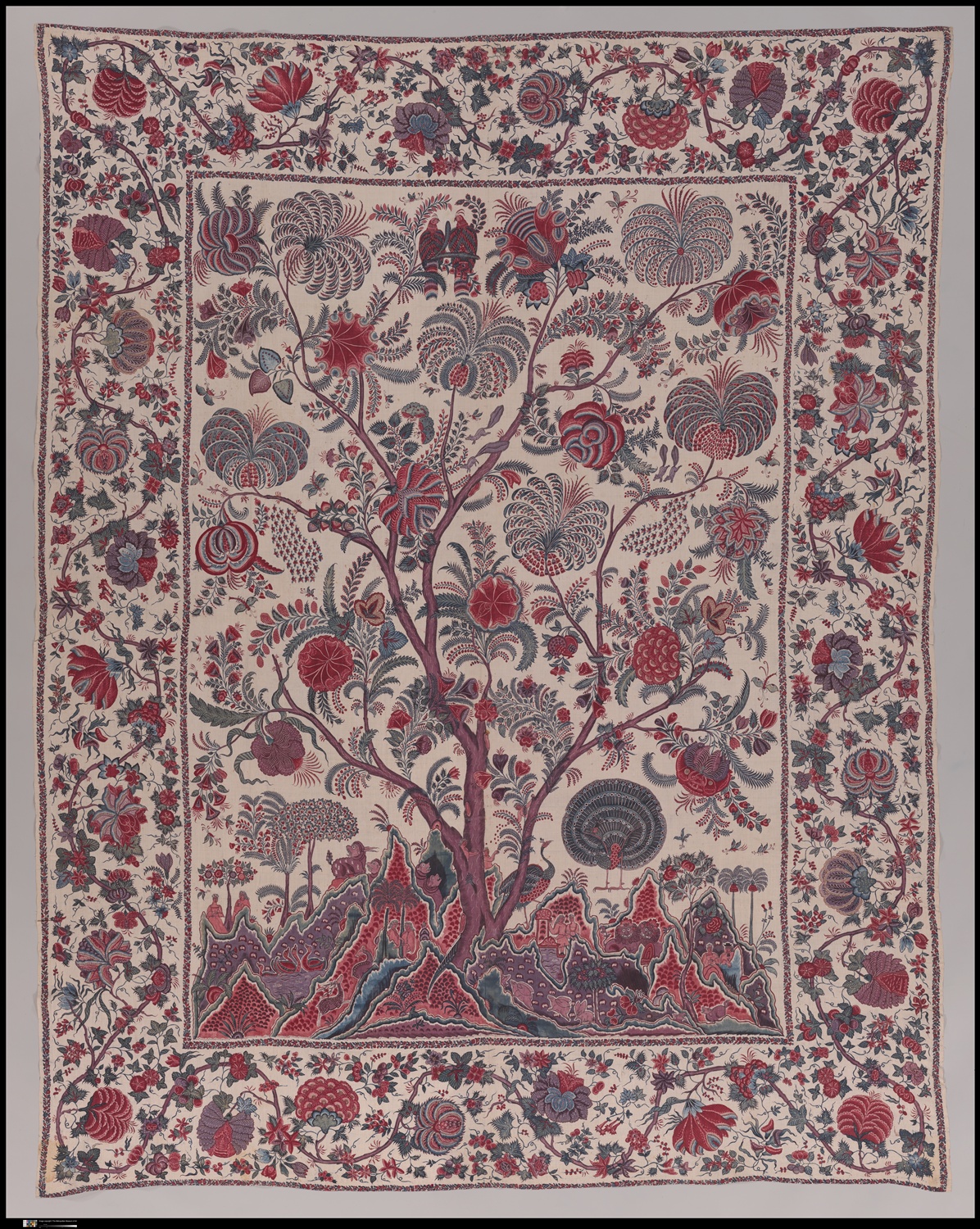

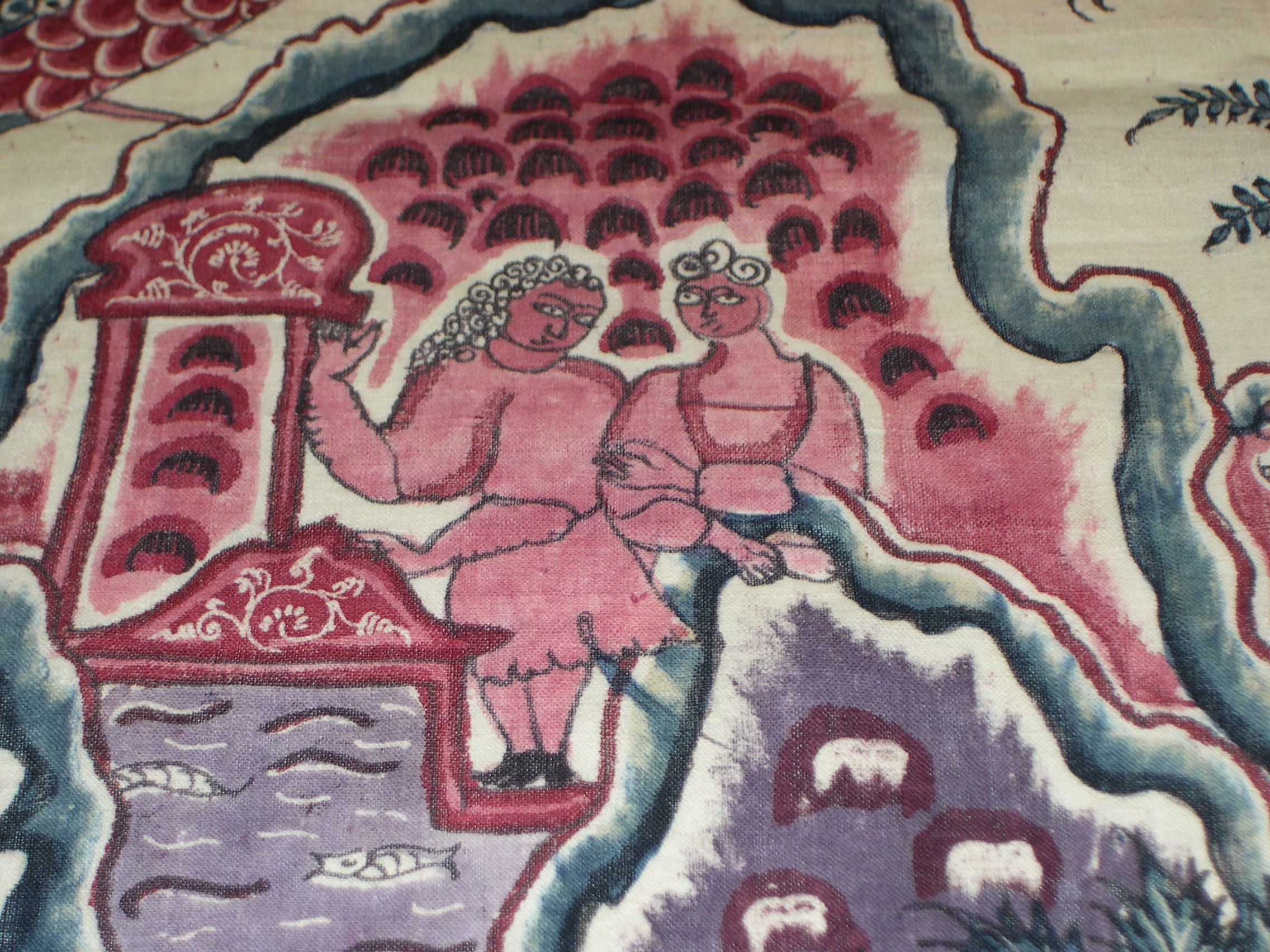
- Mordant- and resist-painted and dyed cotton
- Coromandel Coast, India, probably for the Dutch market
- C. 1760
Philip Van Rensselaer and his extended family of merchants had connections to multiple European port cities. Abroad, Philip and his peers used agents to procure high-end finished goods—from Europe and from the East—for resale in Albany and for their family's use. This rare and costly bedcover, decorated with exotic flora and fauna, would have been the merchant's ultimate symbol of wealth and worldliness.
The figures on the palampore—whether animal or human—are primarily male and female pairs. Additional human figures—tossing fruit from trees—strongly suggest a theme of fertility. These decorations have led scholars to wonder whether the palampore was a wedding gift to Philip and Maria in 1768.
An exception to the male-female pairing is the set of crowned male lions on the textile's lower right. The research of Amelia Peck, Curator of American Decorative Arts at the Metropolitan Museum of Art, reveals that these lions were copied from the “ducaton,” a Dutch coin in circulation during the first half of the eighteenth century. The lions suggest that the piece was made for the Dutch market. They also may symbolize wealth in a way that is almost literal.
This exquisite luxury item survived nearly pristine in Cherry Hill's garret from the 18th century until its discovery during the early years of the museum.
Coin Scale in Box

- C. 1784
This coin scale—in its original box—almost certainly belonged to merchant, Philip Van Rensselaer. A paper affixed to the inside lid is inscribed with the date “May 4, 1784” and with a list of the weights of various types of coins. The set includes seven brass weights.
Side Chair

- Mahogany
- C. 1770
- New York
Letters between Philip Van Rensselaer and his New York City agent, Robert Ray, suggest that Ray procured at least one set of chairs for Philip, to be sent up the Hudson in a sloop to Albany. In fact, the Cherry Hill collection includes pieces from two different sets of New York “Chippendale” chairs, and Colonial Williamsburg owns pieces from yet a third set. Family history recorded by Emily Rankin (1889-1963) indicates that Emily's mother inherited the chairs from her mother, Harriet Maria Van Rensselaer Putman (1825-1860), Philip Van Rensselaer's granddaughter. Harriet Putman inherited the chairs when her childless aunt, Maria Matilda Van Rensselaer Glen (1787-1856), Philip's daughter, died.
This chair can be seen in an 1894 portrait of Emily's brother, Herbert, painted by Albany artist Helen Goodwin when Herbert was seven years old.
Mustard Pot
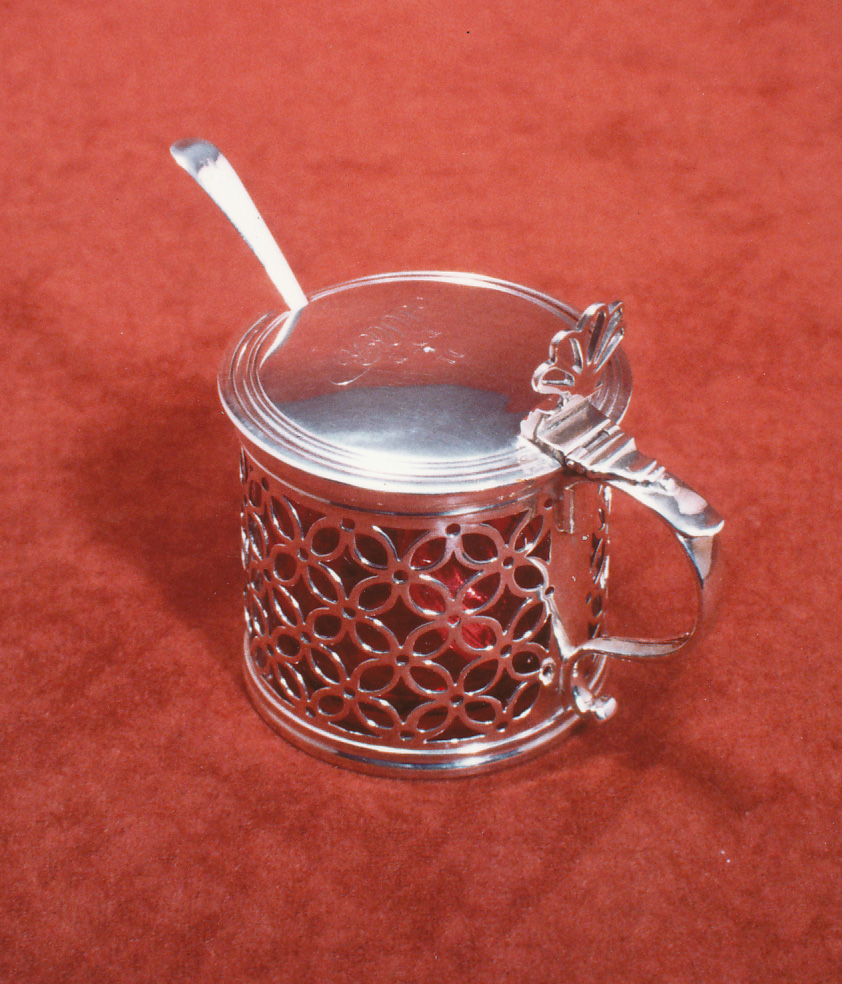
- Silver and glass
- 1767-1768
- London
This mustard pot was almost certainly a wedding gift to Philip and Maria Van Rensselaer in 1768. Hallmarks on the pot's underside indicate its London origin and its date of 1767-1768. The pot's lid is engraved with a conjoined monogram: the letters “P.V.R” with an “M” above.
Philip and Maria's great granddaughter, Catherine Bogart Putman Rankin (1857-1948), commissioned a reproduction of this piece in 1902.
Miniature Portrait
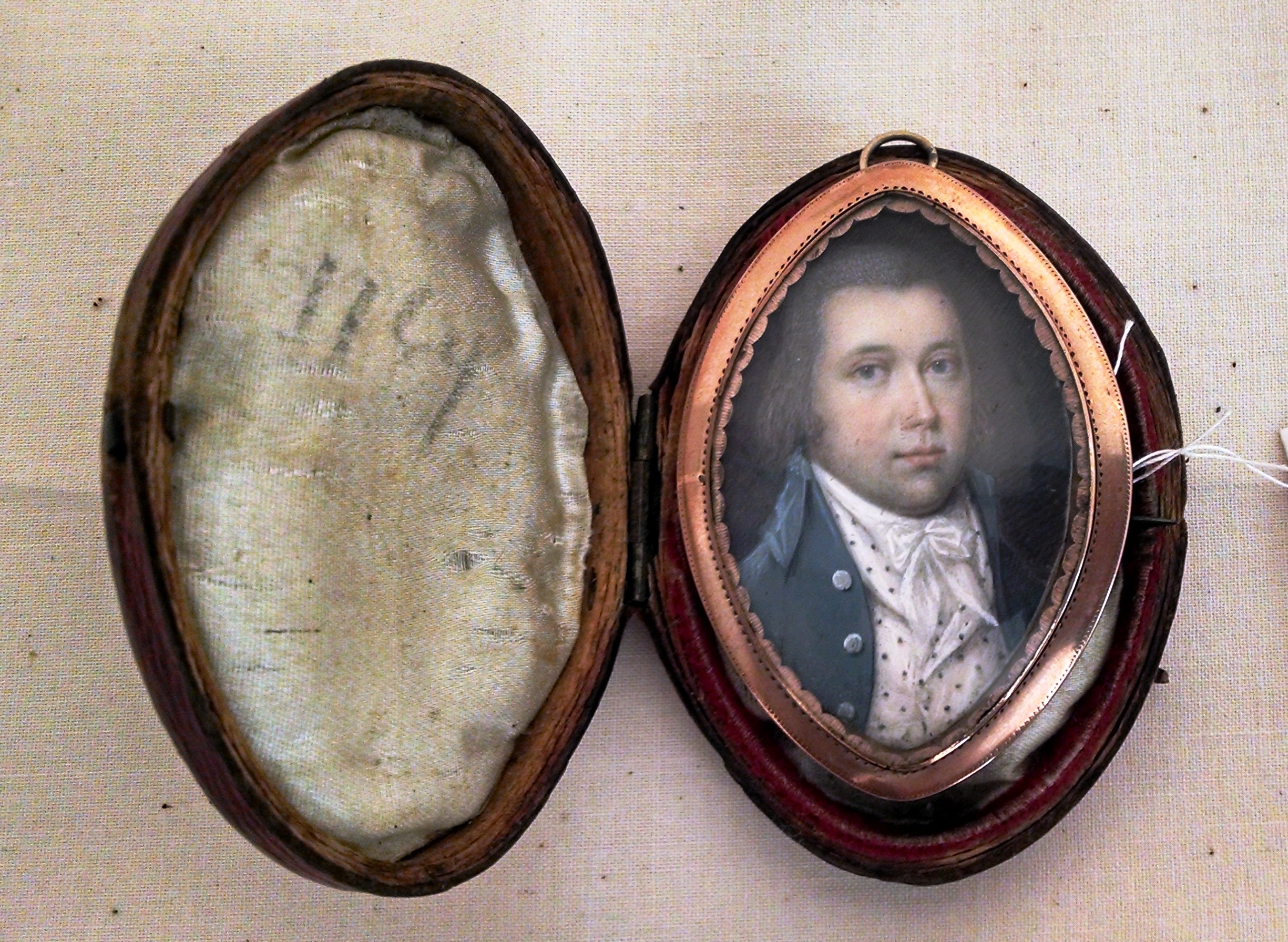
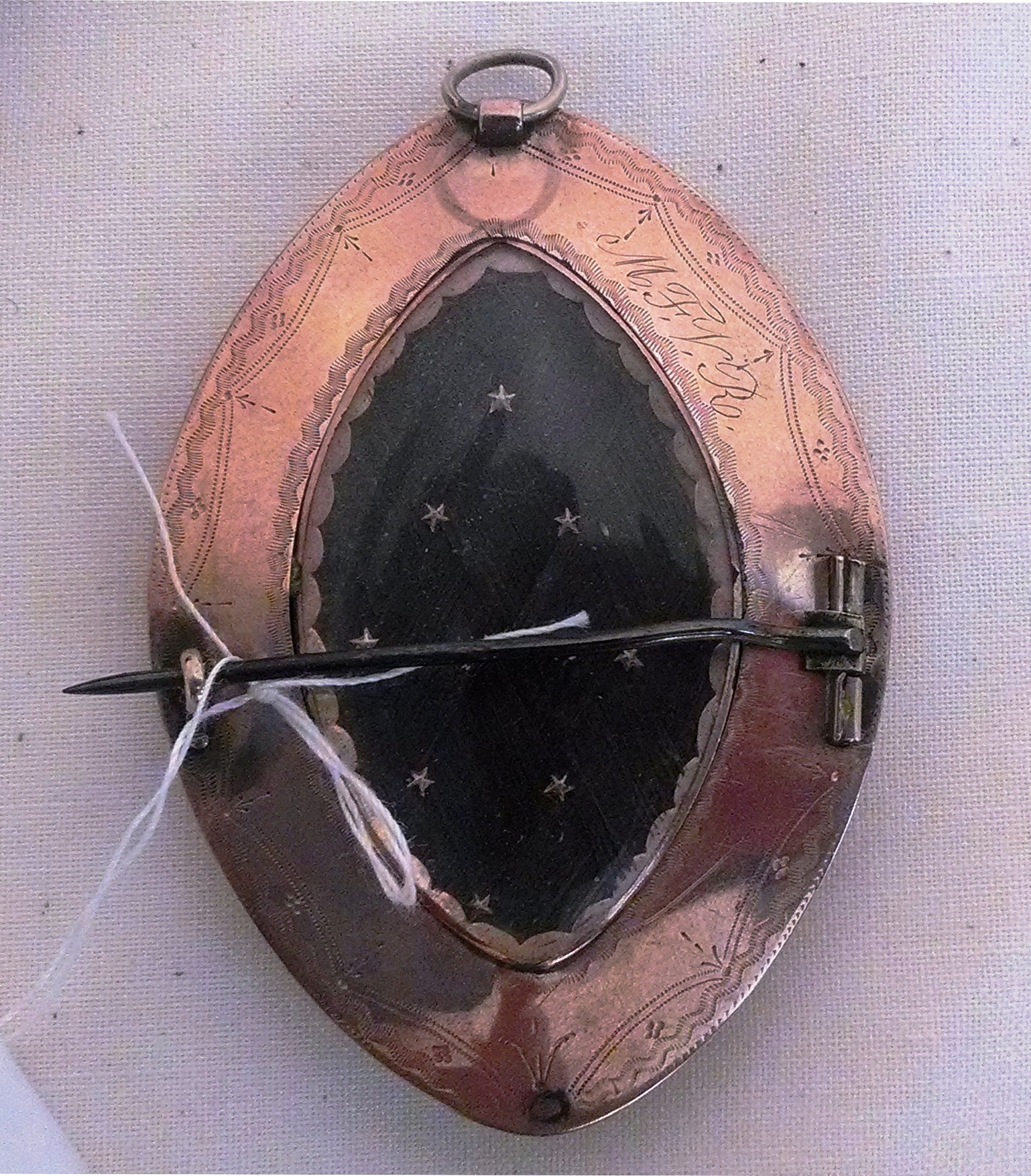
- Attributed to John Ramage (1748-1802)
- Oil on ivory
- c. 1780
- New York
Family tradition suggests that this miniature portrait depicts Philip Van Rensselaer. The painting is set in an elaborate lozenge-shaped case with scalloped inner mat, brightwork engraving, and a woven lock of hair encapsulated on the reverse. Artist-goldsmith John Ramage was known for both his portraits and for his ornate cases. Active in New York City from the Revolution until 1794, Ramage likely painted Philip during one of the merchant's frequent visits down the Hudson to that critical center of trade.
The reverse of the portrait-brooch appears to be inscribed with the monogram “MFVR.” The monogram suggests that the piece was inherited by Matilda Fonda Van Rensselaer (1804-1838), granddaughter of Philip, and wife of Philip's nephew, Richard Van Rensselaer (1797-1880).
The brooch survives it its original red leather outer case.
Indenture


- Between housewright Isaac Packard and Philip Van Rensselaer
- March 1787
This document is the original contract between housewright Isaac Packard and Philip Van Rensselaer for building Cherry Hill. The document specifies a “Well proportioned” timber-frame house with a “Gambril Roof,” 24 windows, beaded board siding, and “a proper Cornice.” The service areas of the house—the cellar kitchens and the garret—are to be finished “in a plain manner” with the floors “laid rough” and doors recycled from the previous dwelling that stood on the site. The first floor and the “Chamber floor,” on the other hand, would have planed floors and new, fashionable six-panel doors. A substantial hall, twelve feet wide, is to run through the house, and a grand stair case will connect the first and second floors.
Cradle



- Leather and brass tacks over white pine
- 1749
- New York
Brass tacks in an undulating design decorate this early cradle—and on the hood, they spell out the date “1749,” the year of Maria Sanders (Van Rensselaer)'s birth. The underside of the cradle is branded “RS,” for Robert Sanders (1705-1765), Maria's father. This is one of the many “inherited” objects in the collection that predate the building of Cherry Hill. Several other furniture pieces are branded “RS.”
Sofa
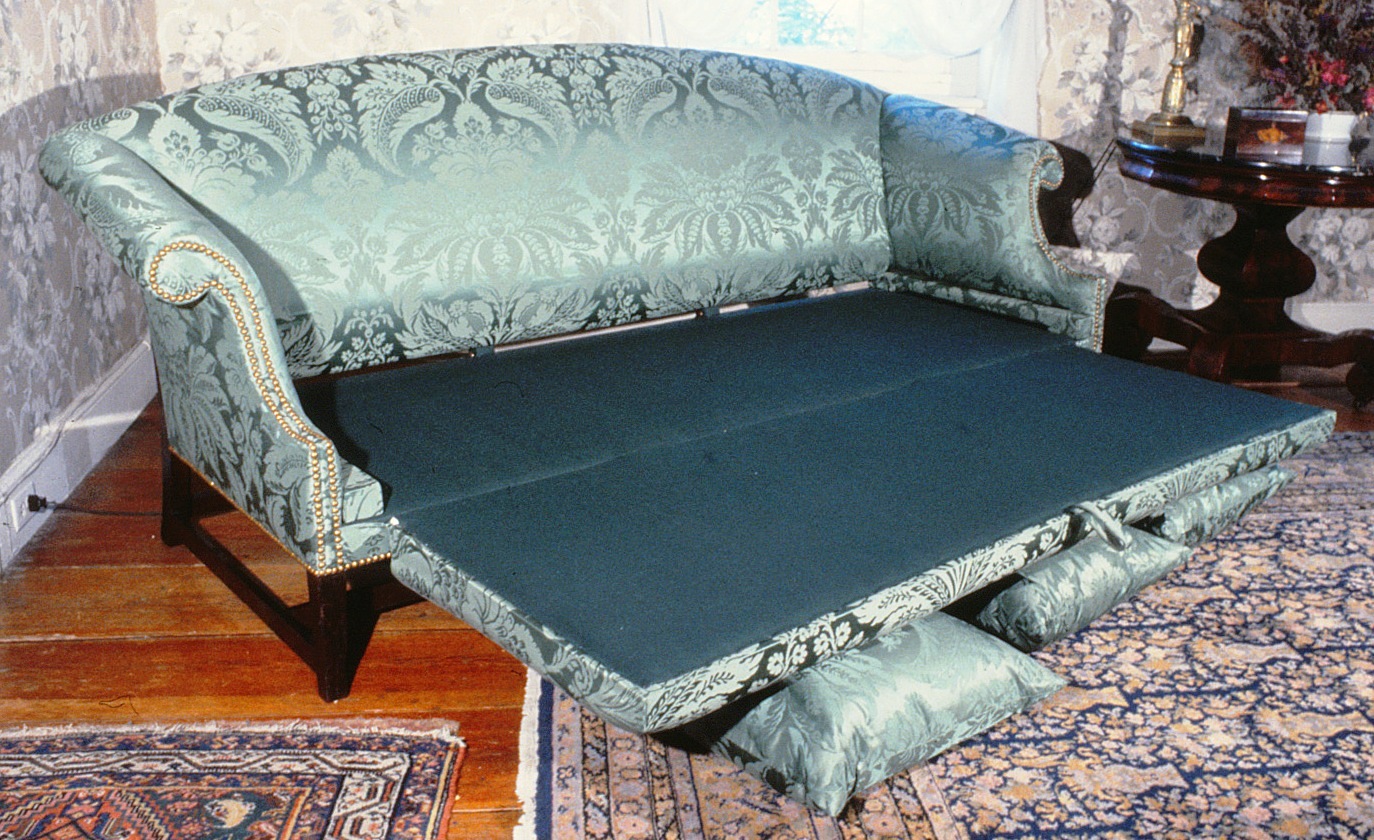
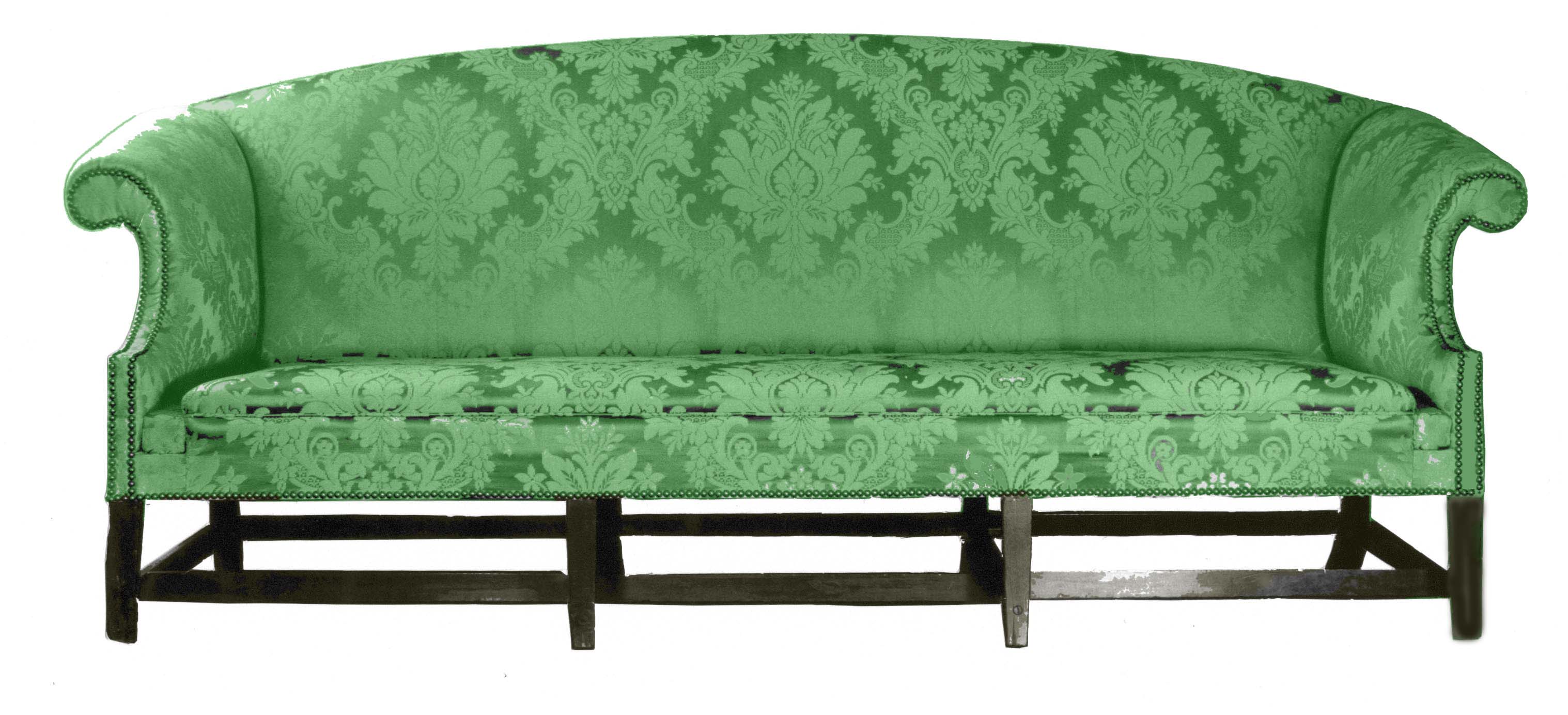
- Mahogany
- C. 1785
- New York
This rare sofa has a fold-out frame by which it converts into a bed. A similar sofa exists at Lorenzo State Historic Site in Cazenovia, New York. Conservator, David Bayne, at the Peebles Island Resource Center, New York State Office of Parks, Recreation and Historic Preservation, has identified yet another convertible sofa at Nostell Priory in West Yorkshire, England. The Priory example may be the precedent for the others, as it may have been made by cabinetmaker Thomas Chippendale, who describes such a sofa-bed in his famous 1762 work, The Gentleman's & Cabinet-Maker's Director. The Cherry Hill example is branded “PVR” on the lower back rail.
Christening Cover
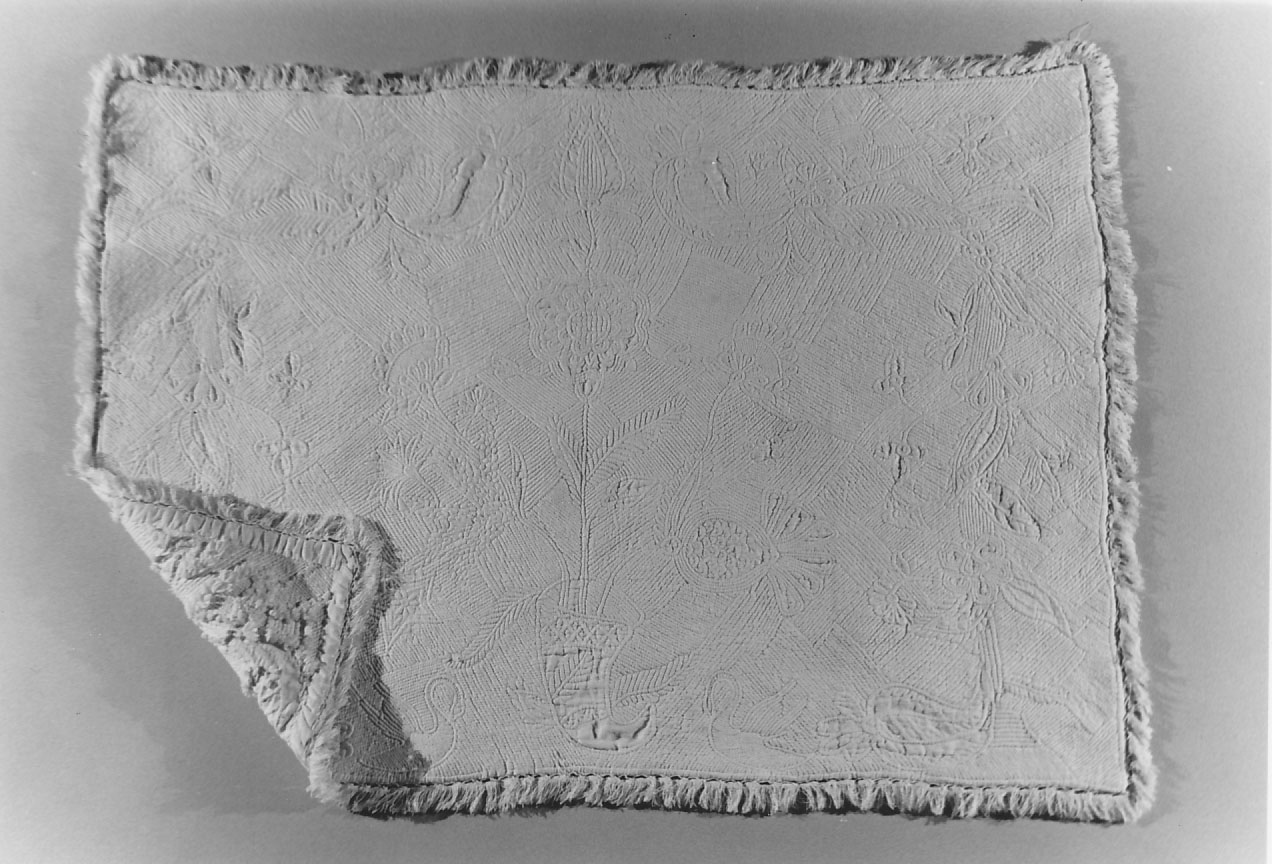
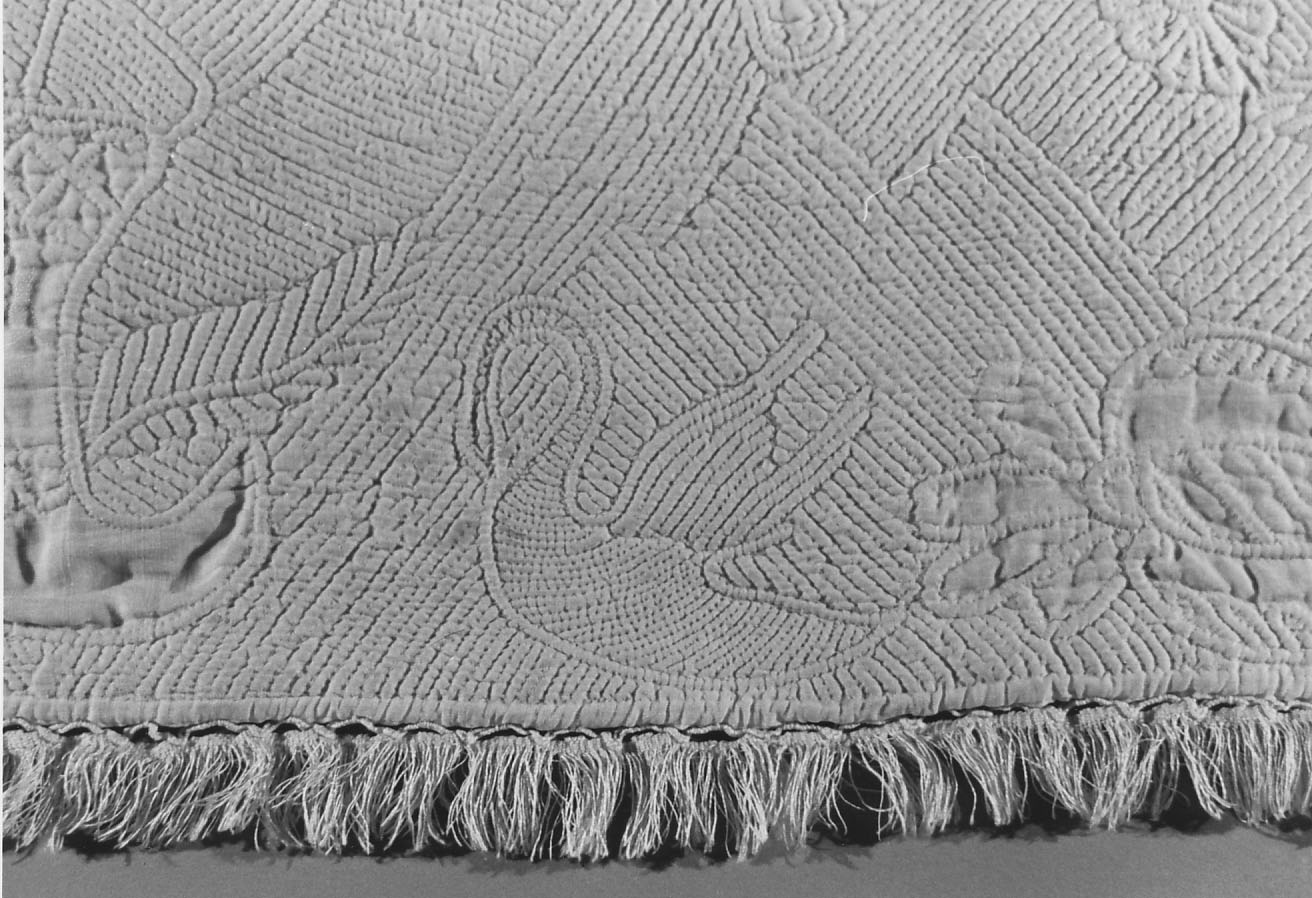
- Linen corded work
- C. 1740
- Probably Europe
The elaborate ornament on this piece likely associates the tiny coverlet with the important occasion of a christening. Given its early date, it is probably among the pieces inherited by Philip or Maria Sanders Van Rensselaer and may plausibly be associated with one of their christenings.
Corded work, sometimes known as Marseilles work, was produced by stitching two cloths (usually cotton or linen) together in decorative parallel lines to form a channel—and then running a cord through the channel to create a raised design. It was made in great quantity by professional needlewomen in Marseilles throughout the seventeenth and eighteenth centuries and exported all over the world. By the eighteenth century corded whitework was being produced elsewhere in Europe as well. Given the mercantile connections of the Sanders-Van Rensselaer family, it is not surprising to find a fine, imported piece like this one among the family possessions.
Receipt Book

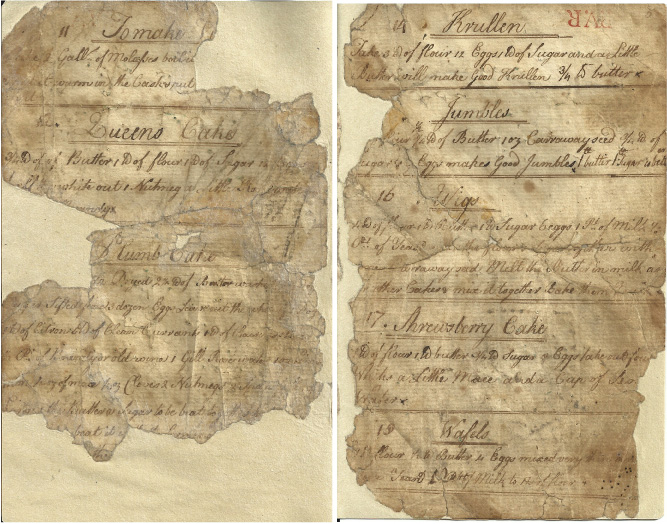
- 1768-1830
- Albany
A collection of recipes for fancy confections, cures, and household necessities (such as glue or shoe polish), this receipt book is the summation of one eighteenth-century mistress's knowledge of all that is needed to run a large, prosperous household. The receipt book was begun in 1768, the year of Maria Sanders marriage to Philip Van Rensselaer and is stamped “PVR” in several places. It is thus believed to have belonged to Maria—though, based on handwriting samples and dates, it appears that Maria's daughter, Arriet Van Rensselaer (1775-1840), may have continued the book after her mother's death. The receipt book includes a recipe for tea cookies, which, according to food historian, Peter Rose, is probably the oldest surviving Dutch-American cookie recipe.